Q: Can we set back our sanctuary thermostat during the week, so we don’t have to heat/cool the room when it is not in use?
![]() A: Yes. If you change the thermostat, the organ’s pitch will change – sharper when it is warmer, flatter when it is colder.
A: Yes. If you change the thermostat, the organ’s pitch will change – sharper when it is warmer, flatter when it is colder.
The tuning will readjust itself when the temperature is set up for Sunday services.
You will notice that the reeds (Trumpet, Oboe, Clarinet, etc.) will sound out of tune with the rest of the organ when the temperature is not at the correct level. This is actually because the pitches of the reed pipes are less affected than the flue pipes around it. So, even though the reeds are blamed for being out of tune, it’s really the rest of the organ that has moved.
Always remember, though, that for the organ to be at its proper pitch, you must allow sufficient time for the room temperature to adjust. If the church reduces the level of heat or air conditioning during the week, you should allow 8 – 12 hours (or 1 hour per degree of difference) for the heat in the room to stabilize, and for the materials in the organ (pipes, chests, windlines, etc.) to also adjust to the new temperature. (See our article Temperature and the Pipe Organ.) We can also offer a humorous little brochure for your trustees that explains the physics of temperature and organ pipes. It’s free.
Just drop us a note.
Q: Should we have our piano tuner match the pitch of the piano to that of the organ?
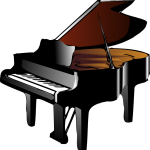 A: Most pipe organs are tuned so they will be at A=440 at normal room temperature (usually about 70º F). Since the pitch of the organ will vary slightly with temperature changes, it is best to have your piano tuned to A=440 instead of trying to match it to the organ pitch. Although there might be a slight variation in pitch between the instruments on any given day, this difference should not be significant.
A: Most pipe organs are tuned so they will be at A=440 at normal room temperature (usually about 70º F). Since the pitch of the organ will vary slightly with temperature changes, it is best to have your piano tuned to A=440 instead of trying to match it to the organ pitch. Although there might be a slight variation in pitch between the instruments on any given day, this difference should not be significant.

Some organs, particularly older historic organs, may be set to a different pitch than A=440, in which case we can advise on a pitch for the piano. Of course, if you never use the organ and piano together, the relative pitches of the instruments is not important.
Q: Our church’s organist is a pianist who has never had formal training on the organ. Is there any way to help him/her make better music on our pipe organ?
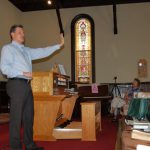 A: The best way, of course, is through private organ instruction with a competent church organist. Since we work with so many churches, we can often recommend an individual that we know is accepting new students.
A: The best way, of course, is through private organ instruction with a competent church organist. Since we work with so many churches, we can often recommend an individual that we know is accepting new students.
In an attempt to help, however, we occasionally sponsor workshops that are open to our customers free of charge. In these one-day sessions, we explore such issues as MIDI and organ registration (how to set up the stops). While these sessions are not a substitute for private instruction, they are designed to help our customers with some of the issues we all face, and to share experiences, knowledge, and fellowship.
There are also devices that can be installed on a new or renovated pipe organ that make service playing easier. These include sophisticated combination actions (presets), automatic transposers, and a device that can automatically supply pedal notes in hymns. We are happy to discuss your church’s specific needs with your organist, and to provide whatever assistance we can.
Q: How can we tell whether or not our old organ is actually worth renovating? Maybe we should just replace it with an electronic organ.
A: When we propose either a new organ or a renovation project for an existing instrument, the first step in the process is to carefully evaluate what you have now. We assess the condition of old pipes, consoles, and mechanical parts, and determine how effectively these can be renewed and how well they would serve in the new design. Since the cost of a set of pipes can be anywhere from $2,000 to over $20,000,
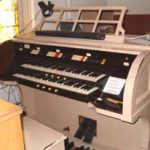
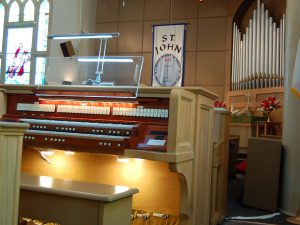
conserving even one set of pipes can provide a very substantial savings!
A very important step in this assessment is to learn how well the organ serves the needs of the congregation, both present and anticipated. We want to understand worship in your church so we can provide an organ for you that is appropriate to your church.
The chances are very good that your organ is well worth the investment to renew it. However, only a pipe organ builder is qualified to assess the condition of your existing pipe organ, and to advise you on whether and how to rebuild it.
In some cases, where space or budget are limited, we can also expand a pipe organ with a few carefully selected digital voice extensions. Our experience with digital and hybrid organs has taught us how these voices can be used effectively. This is a better approach than simply marrying a manufactured digital organ console to a pipe organ. Pipe organ consoles are nearly always better quality, as are t
he control systems. Most importantly, the functioning of the pipe organ is not completely dependent on the digital console.
Too often, electronic organs are chosen by congregations as a line of least resistance, often after a snazzy presentation by a well-schooled salesperson. Electronic organ salespeople ARE NOT qualified to judge the condition of your pipe organ.
Think of it this way, if your car needed repair, would you seek out a qualified mechanic for advice, or a car salesman?
Sadly, when an older pipe organ is replaced with an electronic substitute, an instrument of great artistic and intrinsic value is lost forever. Electr
onic organs have an important place which should be recognized in the musical world, but they remain an inauthentic substitute, and, compared with an artistically designed and voiced pipe organ, second-rate.
By preserving your existing pipe organ, you provide a link between your congregation’s past and its future. Your pipe organ has probably been a part of the worship life of your church for decades, and has provided the musical background for Sunday worship, weddings, funerals, and festival occasions. Even though it may now be in poor mechanical shape, its musical portions, which do not wear out from use, are still filled with music for the future.
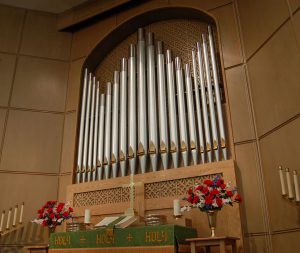
When your congregation first purchased its pipe organ, it probably did so through sacrificial giving. An authentic organ is, and always has been a costly investment. In most cases, however, your church’s entire investment, made generations ago, is preserved in the old organ. The replacement value of all the pipes and parts that can be conserved in an older organ usually far exceeds the total amount of money the church has ever spent on it, including the initial purchase, service over the years, and any improvements that might have been made. Your Board of Trustees would be delighted if any other investment they made, except perhaps in the building, could retain its value so consistently!
When your old organ is renewed, so is its sound! Old pipes can be taught to sing a new song, and new pipes can be added and artistically blended as well. The result can be an organ with a bright, modern ensemble, but that still retains the warmth and grace that has served your church for decades.
At the same time, we can add modern conveniences that will make your organ easier for your organist to manage, and will give the organ extended capabilities that were undreamed-of when it was first given breath.
In our “Dixie-Cup” culture, where artifice is celebrated and “realistic” is confused with “real”, your old pipe organ is an opportunity for your congregation to celebrate the permanent and the authentic.
Besides, a real pipe organ JUST SOUNDS BETTER!
Is your old organ worth it? YOU BET!
Q: Should we have special heat or humidification in our pipe chamber or organ case?
A: The windchests and other parts we build today, because of the materials and construction processes we use, do not require any special environmental conditions beyond those found in most churches.
In most older organs, problems that arise because of weather are a sign that the instrument is ready for a major renovation. These problems, which often happen during the very dry months of our Midwestern winters, are generally caused by the normal shrinking of the wood in the windchests. When the organ was new, the gaskets that keep everything tight had more resilience than they do now, and could compensate for weather changes.
Some windchests, because of their design, are more sensitive than others. In some cases, we will recommend constructing new windchests either because of the superiority of the new windchest design, or because rebuilding the old windchests is unnecessarily costly.
Q: What is MIDI? Should we have it as part of our organ?
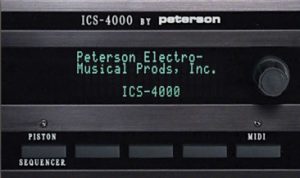
A: MIDI, which is an acronym for Musical Instrument Digital Interface, is a system that allows the control system of the organ to interface with any computer or electronic instrument that follows MIDI protocols.
The most obvious use for a MIDI interface is to allow synthesizers to be played from the organ console. This ability is significant for the performance of a wide range of contemporary music, and is especially useful in choral accompaniments and for events such as weddings, when music is often required that does not sound appropriate with conventional pipe organ sounds. MIDI allows the organist to generate sounds that are not included in the tonal palette of the organ, and are, perhaps, not even organ sounds at all (e.g., the sound of a harp). MIDI systems are becoming so prevalent in organs today that a body of serious organ literature is developing for pipe organ with MIDI.
MIDI also allows the organist to sequence music on the organ. Sequencing is the process whereby the electrical impulses generated in the organ’s control system are digitally encoded on a standard computer disk. Replaying the disk renders the music live on the organ, exactly as the organist recorded it, providing, in effect, a “player” organ.
Sequencing is useful in a number of situations. Music can be recorded for use in situations where the organist must be away from the console. It can also be used for playing music for two organs, such as transcriptions of organ concerti, or for building a library of organ music for use when an organist is unavailable.
Among the most important uses for sequencing is to provide the ability to the organist to record selections during a practice session and then to listen to them from the nave. The organist is then able to hear the music as the congregation hears it and to critique his or her own performance. A number of computer programs are also available that allow sequenced music to be critiqued and edited from a computer.
It is important to understand the distinction between a MIDI Interface, which we provide on most of our new and renovated organs, and MIDI instrumentation. The interface provides the means of communication between the organ and MIDI instruments. The instrumentation itself, whether a synthesizer module or MIDI keyboard, produces the actual sound.
For some customers, we have also installed MIDI instrumentation as a permanent part of their pipe organs, allowing the organist access to this resource without having to set up speakers, amps, and wires.
Q: How can we make our pipe organ console moveable?
A: One of the most important modern trends in church design is flexibility. As worship styles evolve, fixed furnishings in the chancels of many of our churches have become a problem. Pews in the choir loft have given way in may cases to chairs that can be rearranged for the choir, or even removed so the bell choir can set up there.
Most older pipe organ consoles cannot be easily moved. These consoles are connected to the pipes with massive multiple-conductor cables and even wind lines to operate the mechanisms inside the console.
The modern systems we use, such as the Peterson ICS4000, use modern technology to solve this problem. The internal switching in the console is accomplished with solid-state controls similar to those that routinely route millions of phone calls each day over the communications grid. Open contacts, subject to corrosion and dirt, are virtually eliminated. This equipment is fast and silent.
With such a system installed in your pipe organ, your console is connected to the pipes by one cable that is about the same thickness as a pencil. In the case of the ICS4000 system, this cable connects to the organ through a standard Ethernet hub, the same equipment that is used to connect giant computer networks. This proven, dependable technology makes relocating your organ console easy and convenient.
If you wish, we can even provide casters, glides, or a dolly under your console.
Q: How often should our pipe organ be serviced? What is done on a routine service call? How should we prepare for a service visit?

A: Nothing is more important to the longevity, dependability, and musicality of your pipe organ than routine service. This need not be a costly process, especially in smaller organs.
We recommend two service visits per year for most organs, in the spring and fall. These visits are timed to occur after seasonal changeovers between building heat and air conditioning. These visits are scheduled by our office, usually with a phone call or e-mail to the church office, to be sure we don’t conflict with the church’s schedule. We follow up with a post card to the church that will arrive a few days before the scheduled visit.
For the visit to be successful, and to keep the cost of the visit low, it is vitally important that the church prepare for us by doing three simple things:
1. Inform your organist that we are coming. If he/she has had any particular problems with the organ, a note should be left on the console so we can make any needed repairs. Your organist is also welcome to call us at (765) 662-3108, or to e-mail us at service@reynoldsorgans.com.
2. Let your church staff – particularly your custodial staff – know we are coming, and ask them to help us by staying out of the sanctuary while we are working. Conversations and vacuum cleaning can make tuning much more time-consuming, and sometimes impossible.
3. Have the heat or air-conditioning at Sunday morning levels for us. Set these levels in the sanctuary the day before our visit. If the heat in the room isn’t stable, the tuning will not be accurate.
Since we charge for service on a time-and-material basis, along with a fair charge for travel, you will only be charged for the work we actually do. If we encounter anything that might exceed the normal and usual charge for a service visit, we will not exceed the usual charge without authorization. You will NOT receive unexpected large service bills from us!
A routine service visit includes a full tuning of the organ, checking the temperament of each stop, servicing the blower as necessary, checking and adjusting console actions as needed, and any small mechanical adjustments that may be necessary. We usually set the pitch of the organ during the fall visit. The pitch of an organ will usually move slightly sharp during the summer months in response to the weather. This is not harmful.
Your organ’s specific needs may differ from the usual. We would be delighted to discuss your organ with you, and to tailor a service program to your situation.
Q: Should we let other people besides our regular organist play our pipe organ?
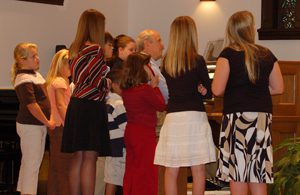
A: Absolutely!
Nothing is better for a pipe organ than to be played. Playing the organ keeps the internal mechanisms working freely. It keeps dust and dirt out of the pipes and off the electrical contacts.
More importantly, though, allowing others to freely use your organ shares your instrument (really God’s instrument) with others. The student that you encourage to practice now may one day serve your church as organist, or substitute for you when your regular organist is not available.
Of course, you should be cognizant of the fact that your organ is a valuable asset of the church. Those who are allowed to practice on it or play it should be either organists or serious students of the organ. They should be checked out by your organist, and should understand and agree to your church’s policies regarding the building and organ.
Most of the new organs we build or instruments we renovate are equipped with huge memory systems that allow guest organists to set up their own combinations and presets without interfering with the settings of the regular musicians of the church.
The bottom line, though, is that it is better for your organ to be played than to be silent. Your pipe organ is filled with music. Let it out!
Q: How can we raise money to refurbish our old organ, or to build a new one?

A: There is an excellent article about this important subject in www.pipeorgans.com, which we recommend you read.
Some pipe organs are purchased through the beneficence of one family or individual. Most, however, are built through the sacrificial giving of a broad cross-section of people.
To do this, it is important to build an appreciation for the King of Instruments in your congregation. Almost nobody in the pew has any idea of the wonderful musical machine hidden behind the screen or the few display pipes. One church sponsored a “petting zoo,” bringing out parts of the organ that most people never see, and letting them actually touch or blow in the pipes. We will be delighted to help you acquaint your congregation with your pipe organ.
A pipe organ is truly a “monumental” investment, in the sense that it is both permanent, and a monument to the strength, vitality, and commitment of those whose vision made it possible.
Some churches include the pipe organ in a broader capital campaign. These campaigns, which are sometimes managed by professional fundraisers, make sense if the church is facing several major projects that can be addressed at the same time.
When fundraising for an organ alone, there are several key components to success.
Have a proposal that is detailed – one that your congregation can believe in and support. Our proposals usually include a report on your existing organ, and carefully reasoned recommendations for its renewal. This is important to people who may be giving sacrificially. Plan and time your campaign carefully. Enlist the support of a few major givers who can give the project momentum before you present it to the larger congregation.
Q: Can our pipe organ be built or rebuilt in phases, instead of all at once?
A: Sometimes this can be done. Although it is usually somewhat more costly in the long run, a phased project can make sense in some cases. With some projects, however, the cost of the backtracking and duplication of labor involved in multiple phases makes such a plan unacceptably costly.
We would be happy to discuss all the possibilities with you, to help you plan a project that is workable in your situation.
Q: What is “tonal finishing”, and why is it important?
A: An organ that has not been carefully finished tonally, has really not been finished at all.
Tonal finishing is the process of carefully regulating the sound of each pipe in an organ in the room in which it will be heard.
All our instruments, from the largest to the smallest, are carefully regulated to provide a rich, even sound.
Q: Can you explain some of the organ jargon I keep hearing, and explain to me in simple terms how a pipe organ works?
A: We have a publication, “Pipe Organs: A Crash Course”, that is available in .pdf format from this web site. This booklet is designed to help you wade through all the organ terminology your committee is probably hearing.
